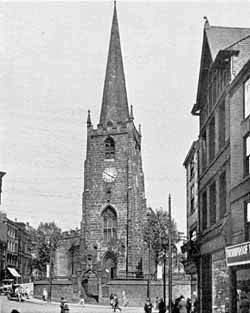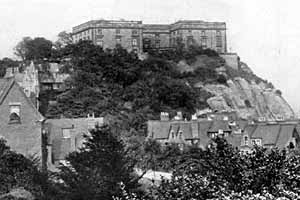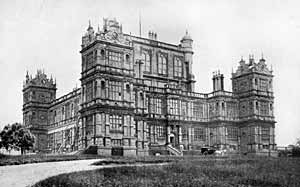ST. PETER’S CHURCH.
 St Peter's church.
St Peter's church.The members of the society then proceeded to St. Peter’s Church, where they were received by Mr. R. Evans, J.P., who had been appointed leader. Mr. Evans addressed the party on the various points of interest in the Church, and afterwards took them round the building. His remarks were to the following effect:—
I regret that I have not more information to give the Society with respect to our old Church of St. Peter, the records being few and imperfect. I will first direct your attention to the oldest portion of the building, viz.: the south arcade of the nave, built in the latter half of the 12th century. Over the arches will be seen the old walling of the early English Church, the high-pitched roof of which is shewn by a well-marked indentation on the eastern face of the tower wall. A peculiarity in the arcade is that the second pier from the west is a massive built pier of masonry, with east and west responds; from this point across the nave remains of a screen or parclose was found during a recent renewal of the floor, the remains consisting of stumps or foot-pieces for carrying the main posts of the screen. You will notice that the piers in this arcade are of good detail and proportion.
The northern arcade is of 14th century work, and was much injured by the erection of a gallery over the whole of the north aisle and across the western end of nave; this occured about 200 years ago; the gallery was removed in 1884.
The clerestory windows are of a debased character, occupying the place of what we believe to have been windows with tracery of the perpendicular period. The nave roof is a fine example of that date; it is said the Strelley family contributed handsomely to the cost through Archbishop Kempe of York, whose crest can be seen on the bosses at the intersections of the beams.
I desire to direct your attention to the fine groined ceiling in the tower, a well constructed piece of masonry.
Abutting on the southern pier of the chancel are the remains of the staircase to the rood loft which is about to be restored, and a new screen and choir stalls eredted through the munificence of Mr. Wm. Gibson. Twenty years ago the present chancel was built on the foundations of what we believe was the ancient building, taking the place of the chancel erected after the demolition of the original one during the Cromwellian period, about 1646.
In this church and churchyard are burials of considerable interest, such as several generations of the Smith family, founders of the well-known banking firm of Messrs. Samuel Smith & Co.; members of the Drury family ; a daughter of the celebrated Col. Hutchinson, and many others, not forgetting the first printer in Nottingham, one Wm. Ayscough, who died in 1719.
In the vestry you will be shewn some old registers, the earliest bearing date 1572, continuing down to the present day, the most interesting book being one in “ black letter,” containing the records of the ancient Guild of St. George, dating back about the middle of the 15th century. Before concluding my remarks on the old church I ought to remind you that there were formerly two chapels dedicated respectively to St. Mary and All Saints’; no remains have been found, but doubtless they were situated at the east end of the north and south aisles.
THE CASTLE.
 Nottingham Castle from The Park.
Nottingham Castle from The Park.At the Castle entrance the party was met by Mr. G. H. Wallis, F.S.A., the art director. Investigation was commenced by a member asking for information respecting the old cistern, dated 1681, with the arms of the Newcastle family moulded thereon, which is just inside the ancient gateway. Mr. Stevenson suggested that it was cast by the bell founders of Nottingham. Attention was then drawn to the old gateway, and at Mr. Wallis’s request Mr. Stevenson entered into an interesting description of it. It was, he said, an Edwardian relic of the ancient Royal Castle. That had always been the entrance to the building. There was no evidence of a portcullis, but he thought that if the bridge near by were examined evidence of a drawbridge would be found. The gateway belonged to the same period as the defences of the town. There was not elsewhere any portion of it above ground. A relic could be seen underground, the north wall having recently been exposed. The wall and the gateway corresponded exactly, both being built of Nottingham sand rock. The arch on the outside seemed to have been prepared for a portcullis, but the groove was not continuous. Mr. Stevenson alluded to the arrow-slits, and then, pointing in the direction of the garden of the General Hospital, said that there was the spot where King Charles raised his standard. Up to about a century ago, he said, the site was marked by a tree. He thought a tablet should be erected. Mr. Stevenson then explained the size of the original castle, indicated the site of the keep, and, after showing the site of a drawbridge, took the party to the bastion by the side of the Castle green, and stated that it represented the earliest evidence of the use of Bulwell stone, besides many other bits of valuable information. Mr, Wallis, in the course of the ramble, indicated the foundation of the original portcullis, and of the barbican. The members of the society then explored the dungeons under the rock, and went down “ Mortimer’s Hole."
From the Castle the party proceeded to the beautiful grounds of Mr. J. W. Leavers, J.P., in which a series of caverns of great antiquity are located. Mr. J. Potter Briscoe pointed out that these caverns were excavated on the escarpment of the new Bunter Sandstone, and that they formerly extended westward and southward. The softness of the rock, and its proximity to the River Trent, suggested that they might be made and utilized by the aborigines as habitations. As families developed and increased, these caves would, with growing needs, be enlarged, and additional openings would be hewn. In connection with these rock holes, the name of the “Druid’s Holes ’’ has been handed down to within the present century. In reference to the Romano-British period, Roman tiles are said to have been found in the chimneys, and a Roman column is said to have formed part of a chapel here. Stretton stated that the style was “evidently Roman." Incineration was said to have been practised here daring the Roman occupation, and in support of this theory the late Mr. Samuel Dutton Walker and Mr. T. C. Hine have stated that an existing opening in the roof of one oi the caverns was the “ Bustum,” or place of cremation, and that the elevated opening, with its many recesses, was the “ Columbarium,” or sepulcral chamber, in the walls of which were niches for urns of ashes. This has been known as “ The Doctor's Shop.” None of the tiles said to have been Romam are known to exist, and may have been of later date, probably Norman. No urns or ashes are recorded to have been discovered here. If this was ever a Roman burial-place of the columbarium type, it is remarkable as being unlike any other in character, for the Romans, invariably it is believed, placed the inurned ashes on masses of masonry, and not, as would be the case in this instance, in recesses of friable rock. An illustrated paper on the subjedt appeared in the first series of “ Old Nottinghamshire.” In pre-Norman times the Church of St. Mary la Roche occupied the site ; previously it would be a hermit’s cell. It developed until it became a Church of considerable dimensions, and later was an adjundt to the neighbouring Priory of Lenton. Mr. Briscoe pointed out a series of holes at regular intervals, which might have been made as resting places for roof supports. Various documents are in existence which relate to St. Mary’s nearly down to the close of the fifteenth century. All that has been written on the ecclesiastical history of these caverns has, in substance, been reproduced, with added material, in Messrs. Stevenson and Stapleton’s chapter on “ The ancient rock-hewn chapel of St. Mary, in Nottingham Park,” in their “ Some account of the religious institutions of Old Nottingham,” published in 1895. Because of their association with the Roman Catholics, portions of these rock-holes were demolished by the Parliamentarians. At this time, and subsequently, these bore the name of "The Papist holes.” For a considerable period the caves were open out to the Leen and the Meadows, but were enclosed and utilized as a Bowling-Green about 1850; and in the early seventies their care devolved upon Mr. Leavers, a gentleman who has preserved them with religious care, and readily permits them to be inspected by all who take interest in these monuments of a a remote past. The party then proceeded to
WOLLATON HALL AND CHURCH.

Wollaton Hall.
The drive which preceded the inspection of Wollaton Hall and Church was a most pleasant one. The party went to Lord Middleton’s famous seat in five conveyances, the hall being reached in good time, 3.30 p.m. This fine specimen of imposing English domestic architecture (1580— 1588), probably the finest in the country, was much admired by the members of the society. The favourable impression made by the exterior of the building was enhanced by the appearance of the interior, over which the society were shown by a competent guide. On leaving the house the party were taken in hand by the Rev. H. C. Russell, Redtor of Wollaton, who, before taking them to the Church, led them over the grounds. The church of St. Leonard, with its interesting monuments of the Willoughby familyt occupied the society till about half-past four. In the evening upwards of thirty members and friends sat down to dinner at the Albert Hotel, under the chairmanship of the Rev. A. J. L. Dobbin. The following, is a complete list:—Mr. Henry Ashwell, Rev. Atwell M. Y. Baylay, Rev. John Bedford, Mr. T. M. Blagg, Mr. Hugh Browne, Rev. R. Jowett Burton, Mr. J. Potter Briscoe, Mr. J. P. Cropper, Rev. A. J. L. Dobbin, Mr, Fredk. Felkin, Mr. Charles Gerring, Mr. John T. Godfrey, Mr. T. K. Gordon, Mr. A. E. Hubbart, Mr. E. M. Kidd, Mr. W. Moore, Mr. G. G. Napier, Mr. W. P. W. Phillimore, Rev. J. E. Phillips, Mr. J. T. Radford, Mr. A. Harris-Reeves, Mr. J. T. Spalding, Rev. J. Standish, Mr. W. Stevenson, Rev. T. W. Swann, Mr. James Ward, Mr. John C. Warren, Mr. G. H. Wallis, Mr. William Wells, and Rev. H. L. Williams.
After the repast the Chairman announced that Lord Hawkesbury (the Chairman of the Council) had written regretting his inability to be present, and proposed “The Health of her Majesty the Queen," which was duly honoured.
The Rev. T. W. Swann, Vicar of Orston and Thoroton, submitted the toast of “ Success to the Thoroton Society.” It was a great pleasure to him to welcome the members to Thoroton on the previous day. They were apt to forget the beauties of their churches, and it was an excellent thing that such a society should come amongst them, and point out the features of their churches and parishes. In this he believed that the society would in this way be of immense advantage. Through the clergymen the inhabitants of the parishes would know more of their churches and the beauties they contained. He had been almost twenty-five years in his present charge, and the remarks made in Thoroton church on the previous day by many people versed in antiquarian lore had induced in him a greater love for his church, and had aroused many feelings almost lost sight of during twenty-five years.
Mr. H. E. Hubbart, in response, said that he was much in favour of the foundation of the society, or of any society which would create an interest in what they called local antiquities. Many of these antiquities were disappearing, partly through ignorance; while the School Board was killing many a tradition. In other parts of the world there were societies which kept a record of every tradition, notably in France, Spain, Italy, Germany, and many parts of America, and he thought it would be well if the Thoroton Society attracted all those into its membership who were interested in every phase of antiquarian research.
On the conclusion of dinner two papers which follow were read by Mr. Stevenson and Mr. Phillimore. This concluded the first annual meeting of the society.
